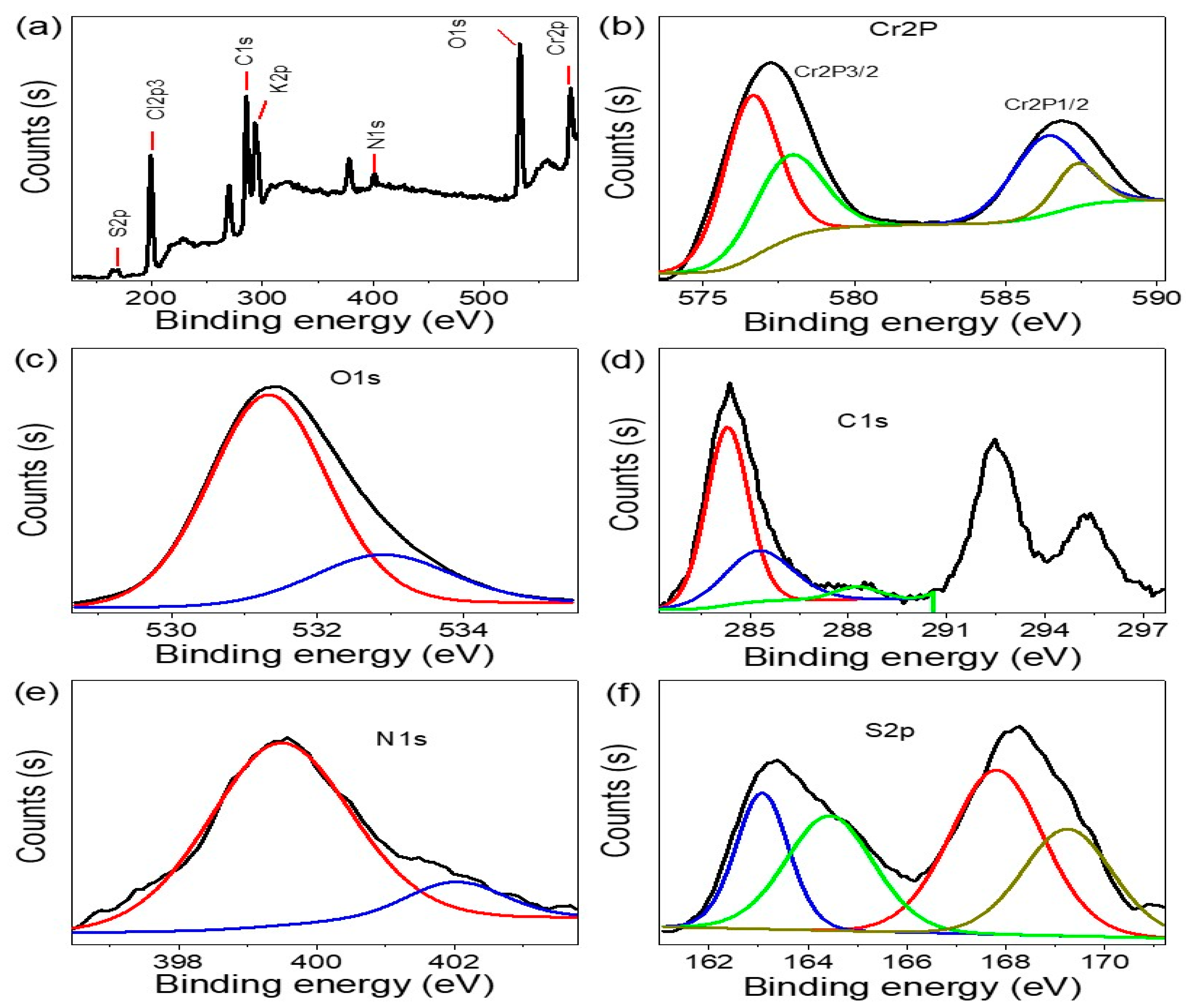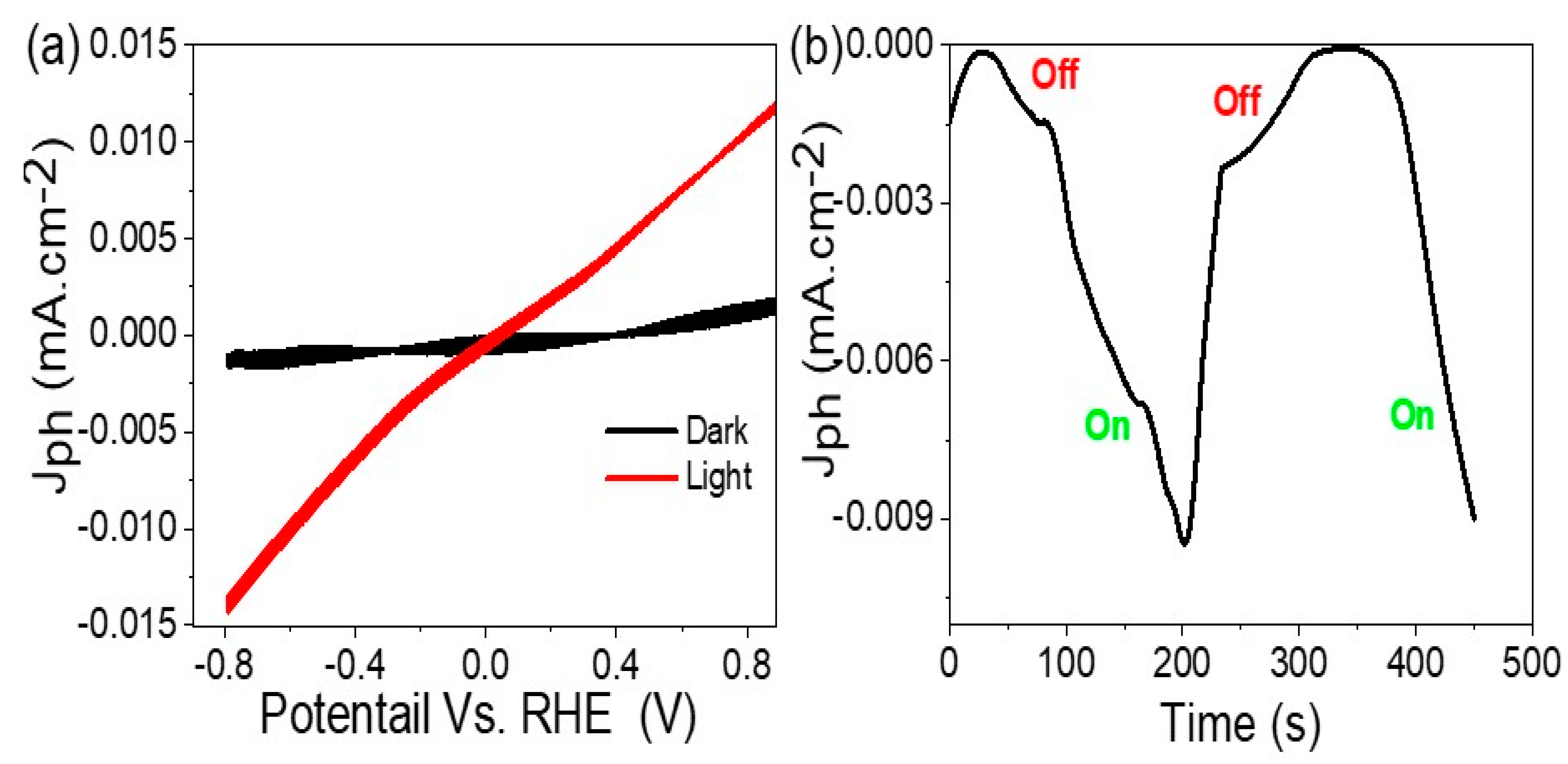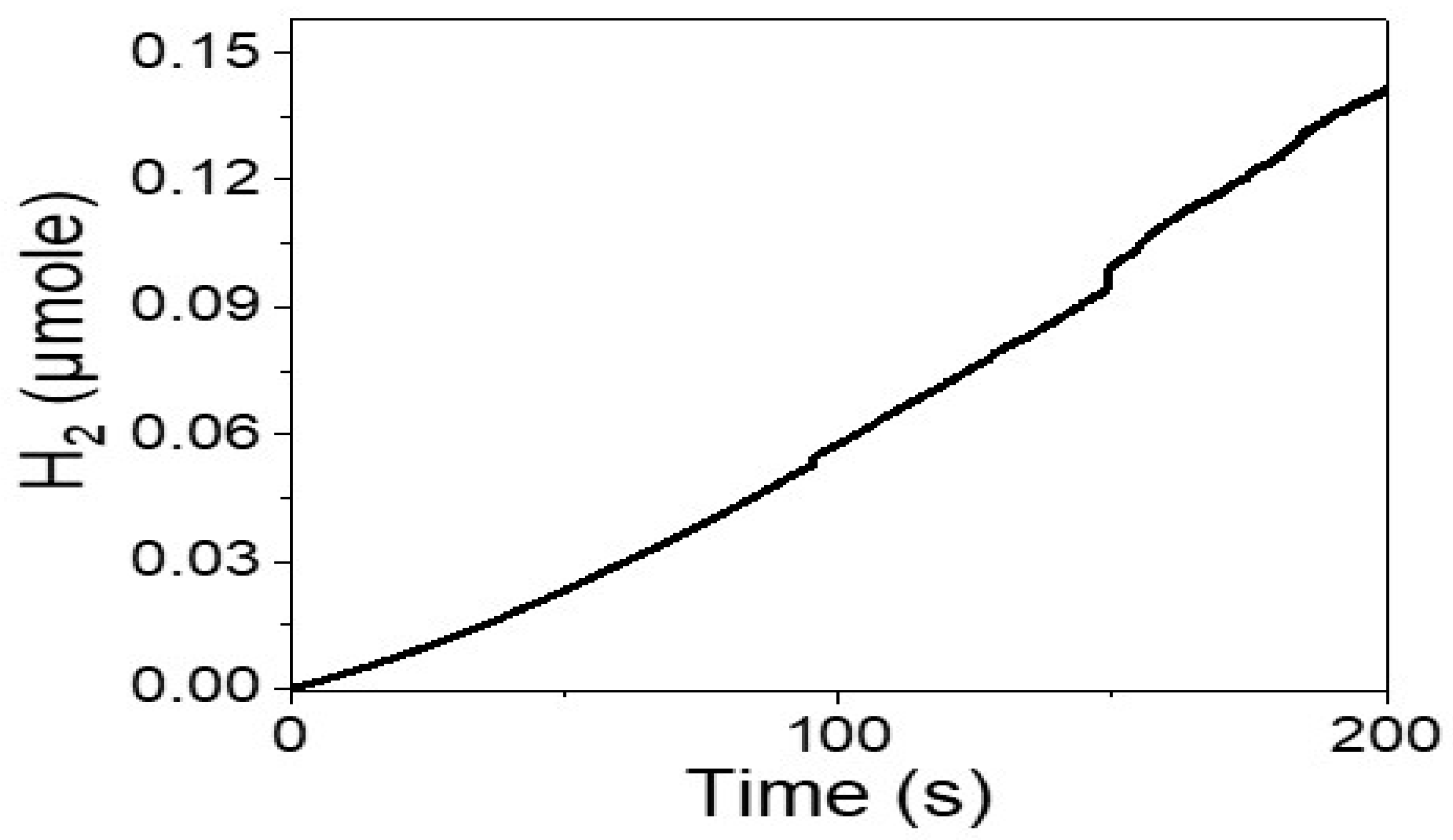Cr2S3-Cr2O3/Poly-2-aminobenzene-1-thiol as a Highly Photocatalytic Material for Green Hydrogen Generation from Sewage Water
Abstract
1. Introduction
2. Materials and Methods
2.1. Characterizations and Used Materials
2.2. P2ABT and Cr(III)oxide/P2ABT Photoelectrode Preparation
2.3. The Hydrogen Generation through the Electrochemical Wastewater Splitting Reaction
3. Results and Discussion
3.1. Analyses
3.2. The Electrochemical Sewage Water Splitting for Hydrogen Gas Generation
4. Conclusions
Author Contributions
Funding
Data Availability Statement
Conflicts of Interest
References
- Hydrogen generation from biomass by pyrolysis. Nat. Rev. Methods Prim. 2022, 2, 21. [CrossRef]
- Liu, Y.; Liu, C.H.; Debnath, T.; Wang, Y.; Pohl, D.; Besteiro, L.V.; Meira, D.M.; Huang, S.; Yang, F.; Rellinghaus, B.; et al. Silver nanoparticle enhanced metal-organic matrix with interface-engineering for efficient photocatalytic hydrogen evolution. Nat. Commun. 2023, 14, 541. [Google Scholar] [CrossRef] [PubMed]
- Xie, H.; Zhao, Z.; Liu, T.; Wu, Y.; Lan, C.; Jiang, W.; Zhu, L.; Wang, Y.; Yang, D.; Shao, Z. A membrane-based seawater electrolyser for hydrogen generation. Nature 2022, 612, 673–678. [Google Scholar] [CrossRef] [PubMed]
- Huang, Y.; Zhong, M.; Huang, Y.; Zhu, M.; Pei, Z.; Wang, Z.; Xue, Q.; Xie, X.; Zhi, C. A self-healable and highly stretchable supercapacitor based on a dual crosslinked polyelectrolyte. Nat. Commun. 2015, 6, 10310. [Google Scholar] [CrossRef]
- Almutairi, M.M.; Ebraheim, E.E.; Mahmoud, M.S.; Atrees, M.S.; Ali, M.E.M.; Khawassek, Y.M. Nanocomposite of TiO2 @ Ni- or Co-doped Graphene Oxide for Efficient Photocatalytic Water Splitting. Egypt. J. Chem. 2019, 62, 1649–1658. [Google Scholar] [CrossRef]
- Mohamadalizadeh, A.; Towfighi, J.; Adinehnia, M.; Bozorgzadeh, H.R. H2S oxidation by multi-wall carbon nanotubes decorated with tungsten sulfide. Korean J. Chem. Eng. 2013, 30, 871–877. [Google Scholar] [CrossRef]
- Ali, I.; Imanova, G.T.; Mbianda, X.Y.; Alharbi, O.M.L. Role of the radiations in water splitting for hydrogen generation. Sustain. Energy Technol. Assess. 2022, 51, 101926. [Google Scholar] [CrossRef]
- Lei, Y.; Huang, Z.H.; Yang, Y.; Shen, W.; Zheng, Y.; Sun, H.; Kang, F. Porous mesocarbon microbeads with graphitic shells: Constructing a high-rate, high-capacity cathode for hybrid supercapacitor. Sci. Rep. 2013, 3, 2477. [Google Scholar] [CrossRef]
- Saha, D.; Kruse, P. Editors’ Choice—Review—Conductive Forms of MoS2 and Their Applications in Energy Storage and Conversion. J. Electrochem. Soc. 2020, 167, 126517. [Google Scholar] [CrossRef]
- Belabed, C.; Abdi, A.; Benabdelghani, Z.; Rekhila, G.; Etxeberria, A.; Trari, M. Photoelectrochemical properties of doped polyaniline: Application to hydrogen photoproduction. Int. J. Hydrogen Energy 2013, 38, 6593–6599. [Google Scholar] [CrossRef]
- Wang, Q.; Ma, X.; Wu, P.; Li, B.; Zhang, L.; Shi, J. CoNiFe-LDHs decorated Ta3N5 nanotube array photoanode for remarkably enhanced photoelectrochemical glycerol conversion coupled with hydrogen generation. Nano Energy 2021, 89, 106326. [Google Scholar] [CrossRef]
- Azzam, E.M.S.; Abd El-Salam, H.M.; Aboad, R.S. Kinetic preparation and antibacterial activity of nanocrystalline poly(2-aminothiophenol). Polym. Bull. 2019, 76, 1929–1947. [Google Scholar] [CrossRef]
- Alruqi, M.; Rabia, M.; Elsayed, A.M.; Hanafi, H.A.; Shaban, M.; Hamid, M.M.A. Development of polypyrrole/Ni(OH)2-NiO core-shell nanocomposite as an optoelectronic device. J. Appl. Polym. Sci. 2023, 140, e53833. [Google Scholar] [CrossRef]
- Gibot, P. Centimetric-Sized Chromium (III) Oxide Object Synthesized by Means of the Carbon Template Replication. Ceramics 2020, 3, 92–100. [Google Scholar] [CrossRef]
- Hussain, W.; Badshah, A.; Hussain, R.A.; Din, I.U.; Aleem, M.A.; Bahadur, A.; Iqbal, S.; Farooq, M.U.; Ali, H. Photocatalytic applications of Cr2S3 synthesized from single and multi-source precursors. Mater. Chem. Phys. 2017, 194, 345–355. [Google Scholar] [CrossRef]
- Helmy, A.; Rabia, M.; Shaban, M.; Ashraf, A.M.; Ahmed, S.; Ahmed, A.M. Graphite/rolled graphene oxide/carbon nanotube photoelectrode for water splitting of exhaust car solution. Int. J. Energy Res. 2020, 44, 7687–7697. [Google Scholar] [CrossRef]
- Rabia, M.; Mohamed, H.S.H.; Shaban, M.; Taha, S. Preparation of polyaniline/PbS core-shell nano/microcomposite and its application for photocatalytic H2 electrogeneration from H2O. Sci. Rep. 2018, 8, 1107. [Google Scholar] [CrossRef]
- Ahmed, A.M.; Rabia, M.; Shaban, M. The structure and photoelectrochemical activity of Cr-doped PbS thin films grown by chemical bath deposition. RSC Adv. 2020, 10, 14458–14470. [Google Scholar] [CrossRef]
- Luo, J.W.; Song, J.D.; Jia, W.Z.; Pu, Z.Y.; Lu, J.Q.; Luo, M.F. Catalytic dehydrofluorination of 1,1,1,3,3-pentafluoropropane to 1,3,3,3-tetrafluoropropene over fluorinated NiO/Cr2O3 catalysts. Appl. Surf. Sci. 2018, 433, 904–913. [Google Scholar] [CrossRef]
- Zhang, W.X.; Liang, Y.; Luo, J.W.; Jia, A.P.; Wang, Y.J.; Lu, J.Q.; Luo, M.F. Morphological effects of ordered Cr2O3 nanorods and Cr2O3 nanoparticles on fluorination of 2-chloro-1,1,1-trifluoroethane. J. Mater. Sci. 2016, 51, 6488–6496. [Google Scholar] [CrossRef]
- Chen, Y.; An, D.; Sun, S.; Gao, J.; Qian, L. Reduction and Removal of Chromium VI in Water by Powdered Activated Carbon. Materials 2018, 11, 269. [Google Scholar] [CrossRef] [PubMed]
- Almohammedi, A.; Shaban, M.; Mostafa, H.; Rabia, M. Nanoporous TiN/TiO2/Alumina Membrane for Photoelectrochemical Hydrogen Production from Sewage Water. Nanomaterials 2021, 11, 2617. [Google Scholar] [CrossRef] [PubMed]
- Hadia, N.M.A.; Shaban, M.; Mohamed, S.H.; Al-Ghamdi, A.F.; Alzaid, M.; Elsayed, A.M.; Mourad, A.H.I.; Amin, M.A.; Boukherroub, R.; Abdelazeez, A.A.A.; et al. Highly crystalline hexagonal PbI2 sheets on polyaniline/antimony tin oxide surface as a novel and highly efficient photodetector in UV, Vis, and near IR regions. Polym. Adv. Technol. 2022, 33, 3977–3987. [Google Scholar] [CrossRef]
- Hadia, N.M.A.; Ahmed, A.M.; Shaban, M.; Mohamed, W.S.; Alzaid, M.; Rabia, M. Flower-like shapes M-PbS (M = Li, na, or Cs)/porous CuO photocatalytic electrode for converting sewage water into H2 fuel gas. J. Mater. Sci. Mater. Electron. 2023, 34, 805. [Google Scholar] [CrossRef]
- Malerød-Fjeld, H.; Clark, D.; Yuste-Tirados, I.; Zanón, R.; Catalán-Martinez, D.; Beeaff, D.; Morejudo, S.H.; Vestre, P.K.; Norby, T.; Haugsrud, R.; et al. Thermo-electrochemical production of compressed hydrogen from methane with near-zero energy loss. Nat. Energy 2017, 2, 923–931. [Google Scholar] [CrossRef]
- Rabia, M.; Mohamed, S.H.; Zhao, H.; Shaban, M.; Lei, Y.; Ahmed, A.M. Correction to: TiO2/TiOxNY hollow mushrooms-like nanocomposite photoanode for hydrogen electrogeneration. J. Porous Mater. 2020, 27, 329. [Google Scholar] [CrossRef]
- Serra, J.M.; Borrás-Morell, J.F.; García-Baños, B.; Balaguer, M.; Plaza-González, P.; Santos-Blasco, J.; Catalán-Martínez, D.; Navarrete, L.; Catalá-Civera, J.M. Hydrogen production via microwave-induced water splitting at low temperature. Nat. Energy 2020, 5, 910–919. [Google Scholar] [CrossRef]
- Rafique, M.; Mubashar, R.; Irshad, M.; Gillani, S.S.A.; Tahir, M.B.; Khalid, N.R.; Yasmin, A.; Shehzad, M.A. A Comprehensive Study on Methods and Materials for Photocatalytic Water Splitting and Hydrogen Production as a Renewable Energy Resource. J. Inorg. Organomet. Polym. Mater. 2020, 30, 3837–3861. [Google Scholar] [CrossRef]
- Myung, J.H.; Neagu, D.; Miller, D.N.; Irvine, J.T.S. Switching on electrocatalytic activity in solid oxide cells. Nature 2016, 537, 528–531. [Google Scholar] [CrossRef]
- Sengodan, S.; Choi, S.; Jun, A.; Shin, T.H.; Ju, Y.W.; Jeong, H.Y.; Shin, J.; Irvine, J.T.S.; Kim, G. Layered oxygen-deficient double perovskite as an efficient and stable anode for direct hydrocarbon solid oxide fuel cells. Nat. Mater. 2015, 14, 205–209. [Google Scholar] [CrossRef]
- Vøllestad, E.; Strandbakke, R.; Tarach, M.; Catalán-Martínez, D.; Fontaine, M.L.; Beeaff, D.; Clark, D.R.; Serra, J.M.; Norby, T. Mixed proton and electron conducting double perovskite anodes for stable and efficient tubular proton ceramic electrolysers. Nat. Mater. 2019, 18, 752–759. [Google Scholar] [CrossRef] [PubMed]
- Abdelazeez, A.A.A.; El-Fatah, G.A.; Shaban, M.; Ahmed, A.M.; Rabia, M. ITO/Poly-3-Methylaniline/Au Electrode for Electrochemical Water Splitting and Dye Removal. ECS J. Solid State Sci. Technol. 2021, 10, 123009. [Google Scholar] [CrossRef]
- Mohamed, F.; Rabia, M.; Shaban, M. Synthesis and characterization of biogenic iron oxides of different nanomorphologies from pomegranate peels for efficient solar hydrogen production. J. Mater. Res. Technol. 2020, 9, 4255–4271. [Google Scholar] [CrossRef]






| Band Position (cm−1) | Function Group | |
|---|---|---|
| Cr2S3-Cr2O3/P2ABT | P2AMB | |
| 3760 | 3743 | N-H |
| 3354 | 3373 | S-H [12] and O-H |
| 1600 | 1621 | quinoid C=C |
| 1473 | 1514 | benzene C=C |
| 1294 | 1304 | C-N |
| 1131 | 1126 | C-H |
| 756 | 757 | Para disubstituted ring |
| 609 | 593 | C-H out of plane |
| Material | Conc, (mg/L) |
|---|---|
| F- | 1.0 |
| CN−1 | 0.1 |
| Phenols | 0.015 |
| Pb2+ | 0.5 |
| Al3+ | 3.0 |
| Cd3+ | 0.05 |
| NH3 | 5.0 |
| Cr3+ | 1.0 |
| Hg2+ | 0.005 |
| Mn2+ | 1.0 |
| As3+ | 0.05 |
| Ba3+ | 2.0 |
| Cu2+ | 1.5 |
| Co2+ | 2.0 |
| Ni3+ | 0.1 |
| Fe3+ | 1.5 |
| Ag+ | 0.1 |
| Zn2+ | 5.0 |
| Other cations | 0.1 |
| Pesticides | 0.2 |
| Coli groups | 4000/100 cm3 |
| Industrial washing | 0.5 |
Disclaimer/Publisher’s Note: The statements, opinions and data contained in all publications are solely those of the individual author(s) and contributor(s) and not of MDPI and/or the editor(s). MDPI and/or the editor(s) disclaim responsibility for any injury to people or property resulting from any ideas, methods, instructions or products referred to in the content. |
© 2023 by the authors. Licensee MDPI, Basel, Switzerland. This article is an open access article distributed under the terms and conditions of the Creative Commons Attribution (CC BY) license (https://creativecommons.org/licenses/by/4.0/).
Share and Cite
Rabia, M.; Elsayed, A.M.; Abdallah Alnuwaiser, M. Cr2S3-Cr2O3/Poly-2-aminobenzene-1-thiol as a Highly Photocatalytic Material for Green Hydrogen Generation from Sewage Water. Micromachines 2023, 14, 1567. https://doi.org/10.3390/mi14081567
Rabia M, Elsayed AM, Abdallah Alnuwaiser M. Cr2S3-Cr2O3/Poly-2-aminobenzene-1-thiol as a Highly Photocatalytic Material for Green Hydrogen Generation from Sewage Water. Micromachines. 2023; 14(8):1567. https://doi.org/10.3390/mi14081567
Chicago/Turabian StyleRabia, Mohamed, Asmaa M. Elsayed, and Maha Abdallah Alnuwaiser. 2023. "Cr2S3-Cr2O3/Poly-2-aminobenzene-1-thiol as a Highly Photocatalytic Material for Green Hydrogen Generation from Sewage Water" Micromachines 14, no. 8: 1567. https://doi.org/10.3390/mi14081567
APA StyleRabia, M., Elsayed, A. M., & Abdallah Alnuwaiser, M. (2023). Cr2S3-Cr2O3/Poly-2-aminobenzene-1-thiol as a Highly Photocatalytic Material for Green Hydrogen Generation from Sewage Water. Micromachines, 14(8), 1567. https://doi.org/10.3390/mi14081567







